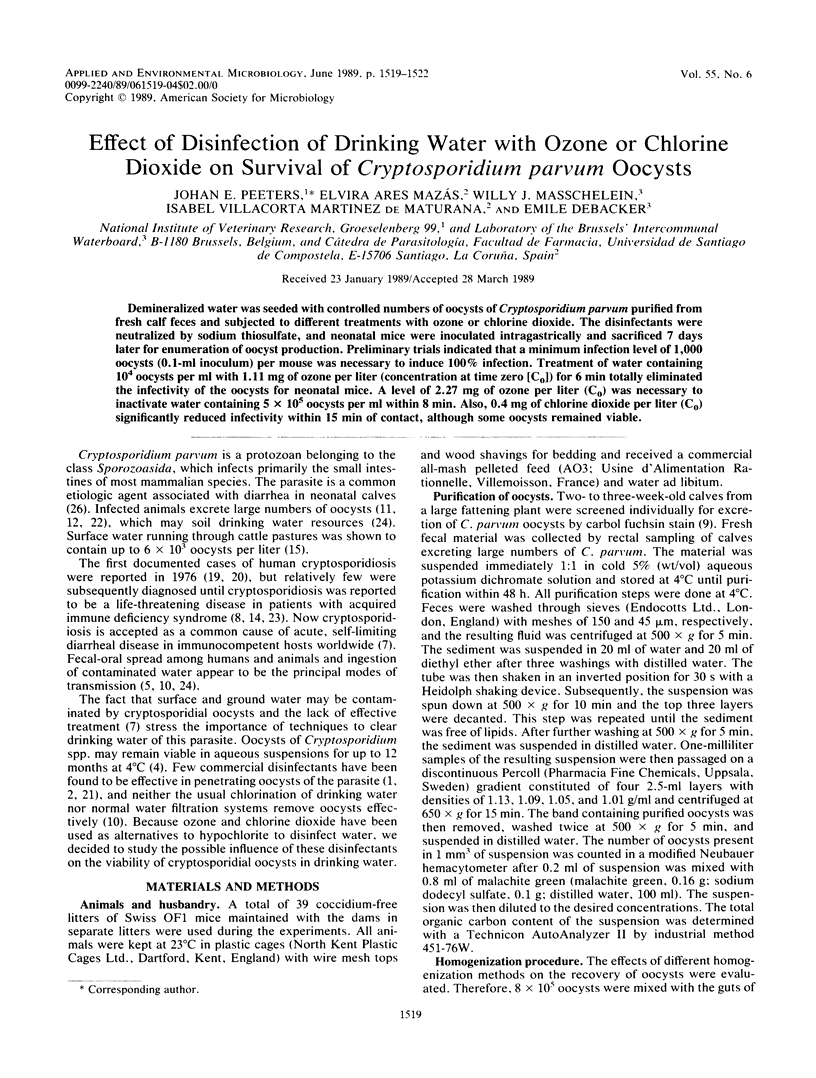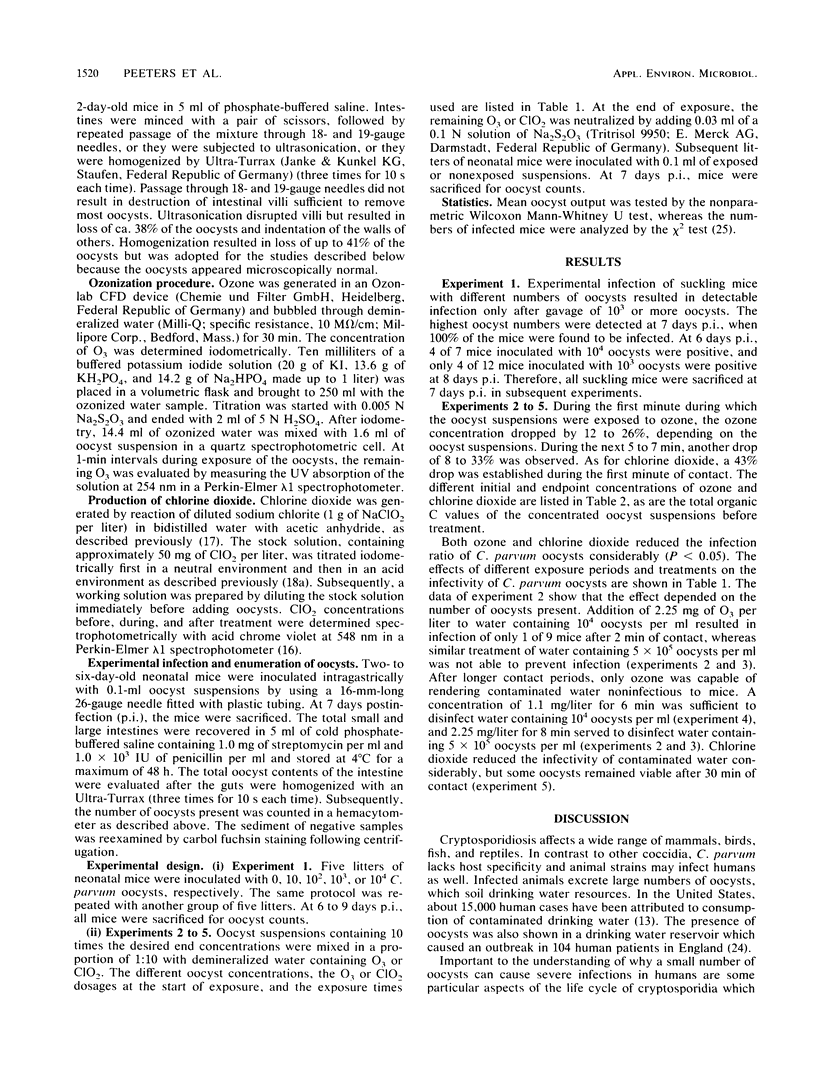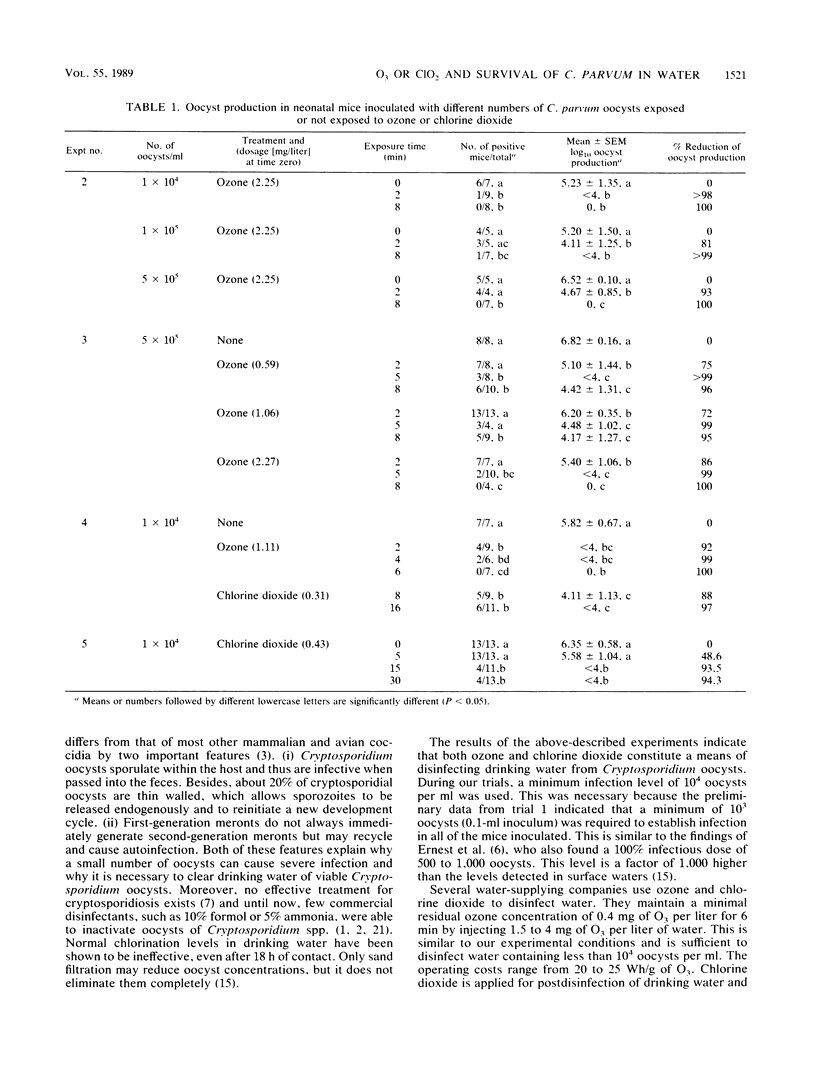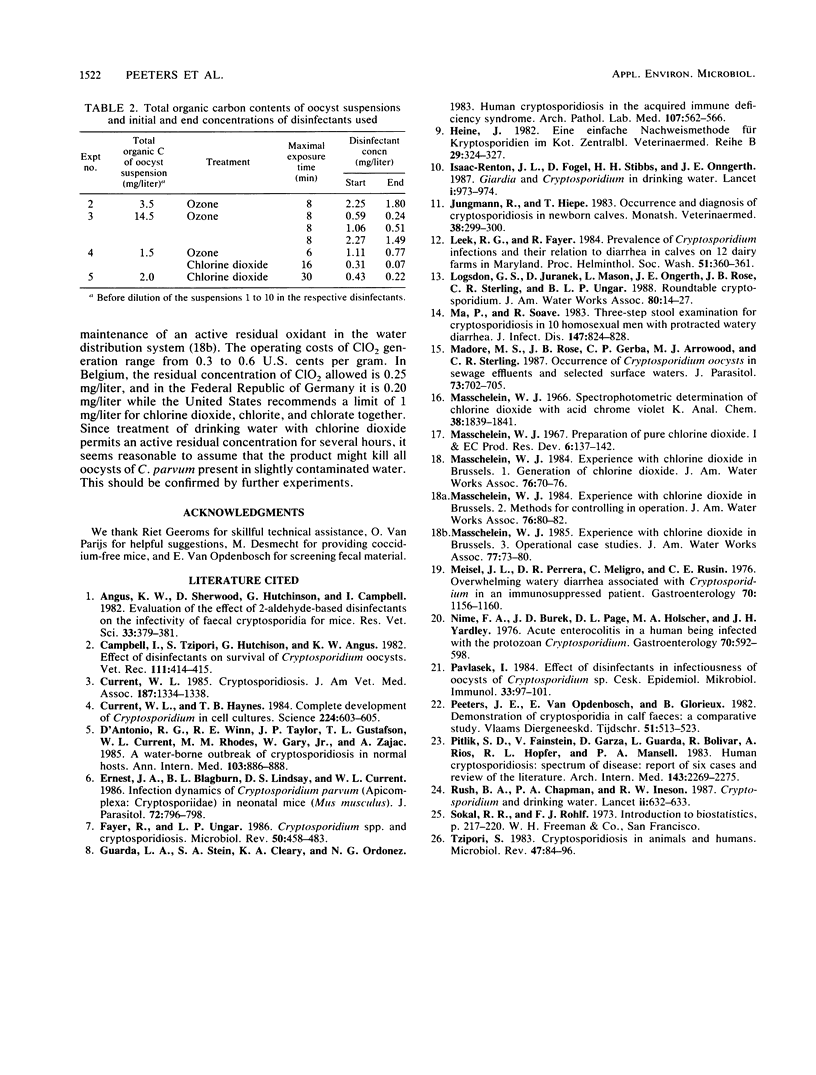Abstract
Demineralized water was seeded with controlled numbers of oocysts of Cryptosporidium parvum purified from fresh calf feces and subjected to different treatments with ozone or chlorine dioxide. The disinfectants were neutralized by sodium thiosulfate, and neonatal mice were inoculated intragastrically and sacrificed 7 days later for enumeration of oocyst production. Preliminary trials indicated that a minimum infection level of 1,000 oocysts (0.1-ml inoculum) per mouse was necessary to induce 100% infection. Treatment of water containing 10(4) oocysts per ml with 1.11 mg of ozone per liter (concentration at time zero [C0]) for 6 min totally eliminated the infectivity of the oocysts for neonatal mice. A level of 2.27 mg of ozone per liter (C0) was necessary to inactivate water containing 5 x 10(5) oocysts per ml within 8 min. Also, 0.4 mg of chlorine dioxide per liter (C0) significantly reduced infectivity within 15 min of contact, although some oocysts remained viable.
Full text
PDF



Selected References
These references are in PubMed. This may not be the complete list of references from this article.
- Angus K. W., Sherwood D., Hutchison G., Campbell I. Evaluation of the effect of two aldehyde-based disinfectants on the infectivity of faecal cryptosporidia for mice. Res Vet Sci. 1982 Nov;33(3):379–381. [PubMed] [Google Scholar]
- Campbell I., Tzipori A. S., Hutchison G., Angus K. W. Effect of disinfectants on survival of cryptosporidium oocysts. Vet Rec. 1982 Oct 30;111(18):414–415. doi: 10.1136/vr.111.18.414. [DOI] [PubMed] [Google Scholar]
- Current W. L. Cryptosporidiosis. J Am Vet Med Assoc. 1985 Dec 15;187(12):1334–1338. [PubMed] [Google Scholar]
- Current W. L., Haynes T. B. Complete development of Cryptosporidium in cell culture. Science. 1984 May 11;224(4649):603–605. doi: 10.1126/science.6710159. [DOI] [PubMed] [Google Scholar]
- D'Antonio R. G., Winn R. E., Taylor J. P., Gustafson T. L., Current W. L., Rhodes M. M., Gary G. W., Jr, Zajac R. A. A waterborne outbreak of cryptosporidiosis in normal hosts. Ann Intern Med. 1985 Dec;103(6 ):886–888. doi: 10.7326/0003-4819-103-6-886. [DOI] [PubMed] [Google Scholar]
- Ernest J. A., Blagburn B. L., Lindsay D. S., Current W. L. Infection dynamics of Cryptosporidium parvum (Apicomplexa: Cryptosporiidae) in neonatal mice (Mus musculus). J Parasitol. 1986 Oct;72(5):796–798. [PubMed] [Google Scholar]
- Fayer R., Ungar B. L. Cryptosporidium spp. and cryptosporidiosis. Microbiol Rev. 1986 Dec;50(4):458–483. doi: 10.1128/mr.50.4.458-483.1986. [DOI] [PMC free article] [PubMed] [Google Scholar]
- Guarda L. A., Stein S. A., Cleary K. A., Ordóez N. G. Human cryptosporidiosis in the acquired immune deficiency syndrome. Arch Pathol Lab Med. 1983 Nov;107(11):562–566. [PubMed] [Google Scholar]
- Heine J. Eine einfache Nachweismethode für Kryptosporidien im Kot. Zentralbl Veterinarmed B. 1982 May;29(4):324–327. [PubMed] [Google Scholar]
- Isaac-Renton J. L., Fogel D., Stibbs H. H., Ongerth J. E. Giardia and Cryptosporidium in drinking water. Lancet. 1987 Apr 25;1(8539):973–974. doi: 10.1016/s0140-6736(87)90313-8. [DOI] [PubMed] [Google Scholar]
- Ma P., Soave R. Three-step stool examination for cryptosporidiosis in 10 homosexual men with protracted watery diarrhea. J Infect Dis. 1983 May;147(5):824–828. doi: 10.1093/infdis/147.5.824. [DOI] [PubMed] [Google Scholar]
- Madore M. S., Rose J. B., Gerba C. P., Arrowood M. J., Sterling C. R. Occurrence of Cryptosporidium oocysts in sewage effluents and selected surface waters. J Parasitol. 1987 Aug;73(4):702–705. [PubMed] [Google Scholar]
- Meisel J. L., Perera D. R., Meligro C., Rubin C. E. Overwhelming watery diarrhea associated with a cryptosporidium in an immunosuppressed patient. Gastroenterology. 1976 Jun;70(6):1156–1160. [PubMed] [Google Scholar]
- Nime F. A., Burek J. D., Page D. L., Holscher M. A., Yardley J. H. Acute enterocolitis in a human being infected with the protozoan Cryptosporidium. Gastroenterology. 1976 Apr;70(4):592–598. [PubMed] [Google Scholar]
- Pavlásek I. Ucinek dezinfekcních prostredků na infekceschopnost oocyst Cryptosporidium sp. Cesk Epidemiol Mikrobiol Imunol. 1984 Mar;33(2):97–101. [PubMed] [Google Scholar]
- Pitlik S. D., Fainstein V., Garza D., Guarda L., Bolivar R., Rios A., Hopfer R. L., Mansell P. A. Human cryptosporidiosis: spectrum of disease. Report of six cases and review of the literature. Arch Intern Med. 1983 Dec;143(12):2269–2275. doi: 10.1001/archinte.1983.00350120059015. [DOI] [PubMed] [Google Scholar]
- Rush B. A., Chapman P. A., Ineson R. W. Cryptosporidium and drinking water. Lancet. 1987 Sep 12;2(8559):632–633. doi: 10.1016/s0140-6736(87)93029-7. [DOI] [PubMed] [Google Scholar]
- Tzipori S. Cryptosporidiosis in animals and humans. Microbiol Rev. 1983 Mar;47(1):84–96. doi: 10.1128/mr.47.1.84-96.1983. [DOI] [PMC free article] [PubMed] [Google Scholar]


